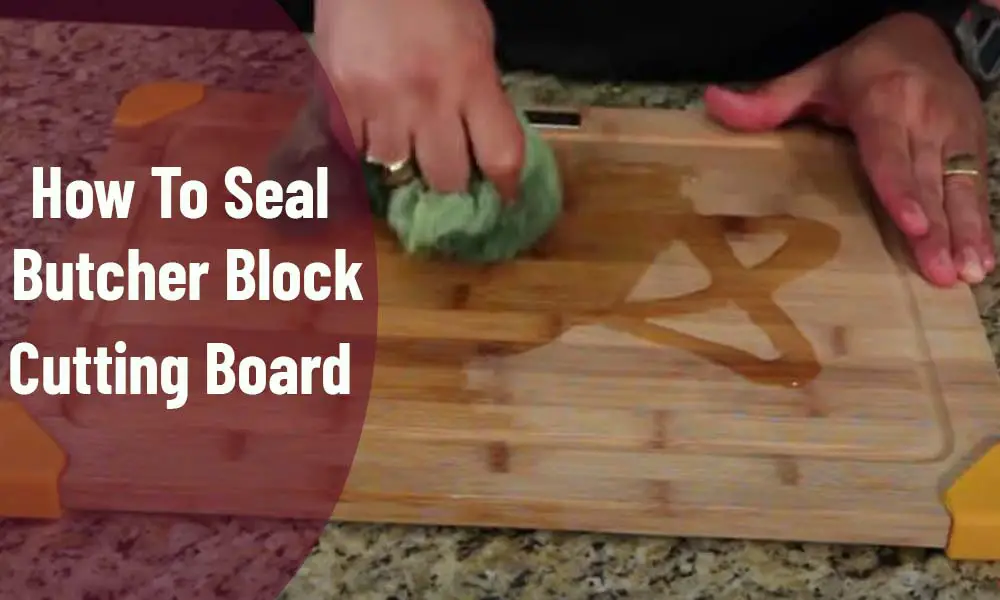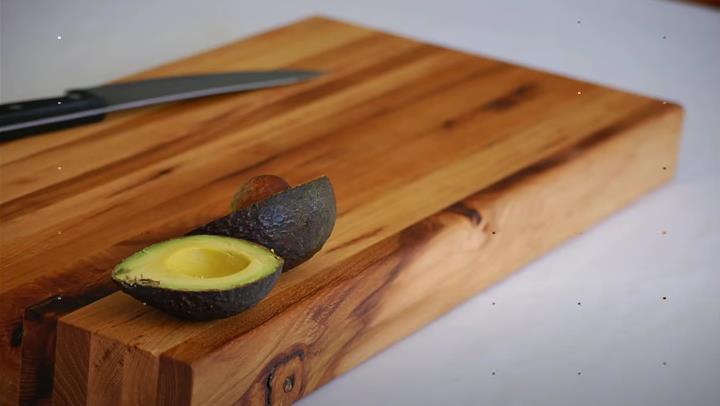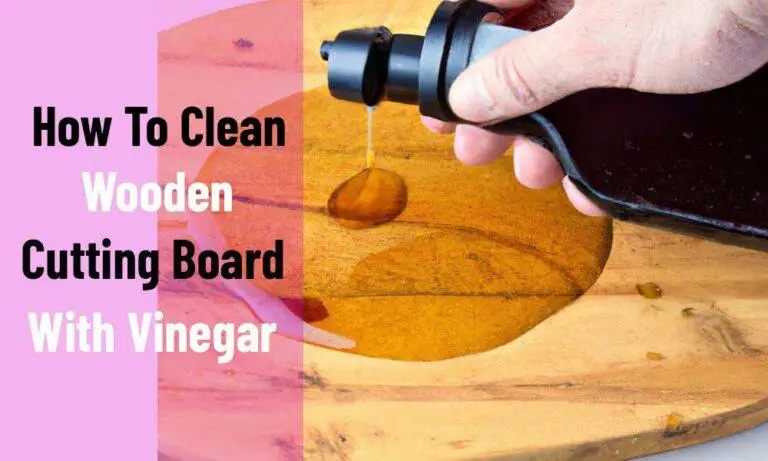How To Seal A Butcher Block Cutting Board? Expert Tips

Sealing a butcher block cutting board is essential to keeping it looking good and in working condition. It is also vital for protecting the wood from moisture and staining.
So knowing how to seal a butcher block cutting board is vital. Sealing a butcher block cutting board is easy and can be done in a few steps. To seal a butcher block cutting board, sand it to remove any rough spots, clean the surface with a damp cloth, apply a food-grade oil or wax, and allow it to soak in.
In this blog, I’ll provide a detailed guide to help seal your butcher block cutting board correctly. Read on to find out how.
What Is A Butcher Block Cutting Board?
A butcher block cutting board is made of thick strips of hardwood glued together. The result is a strong surface that can take a lot of use in a kitchen.
Hardwoods like maple, oak, or cherry are often used to make butcher block cutting boards. The wood strips are assembled so the grain goes in different directions. It keeps the board from warping over time.
Professional kitchens like butcher block cutting boards because they last longer and don’t show knife marks. They can also be used as a surface for kneading dough or rolling out pastry because the hardwood surface is stable and even.
It’s important to remember that butcher block cutting boards must be cared for regularly to stay in good shape. They should be oiled often to keep the wood from drying out, and each time they are used, they should be cleaned with mild soap and water.
Step-by-step guide on How To Seal A Butcher Block Cutting Board

Sealing a butcher block cutting board is crucial to protecting it from moisture, stains, and bacteria. Here’s a step-by-step guide on how to seal a butcher block cutting board:
Sep-1. Gather Supplies Needed:
You must gather a few supplies to seal your butcher block cutting board. Like:
- cutting board
- food-safe mineral oil
- soft cloth
- and a spoon
Step-2. Clean The Cutting Board With Warm, Soapy Water
Before sealing a butcher block cutting board, it is essential to clean it properly. Use warm soapy water and a scrub brush to clean the cutting board. After cleaning it with soapy water, rinse the cutting board and dry it with a clean cloth. If there are any stubborn stains, use a mild abrasive cleaner to remove them. Rinse the cutting board thoroughly.
Step-3. Dry The Board Thoroughly
After cleaning the board, it is essential to dry it thoroughly. Use a soft cloth to pat dry the surface of the board. You can also leave it to air dry for a few hours. Make sure to dry both sides of the board. Otherwise, the sealant may not adhere to the surface properly.
Step-4. With A Spoon, Coat The Board With Mineral Oil
Once the butcher block is prepped and sanded, it is time to apply the mineral oil. Spread a thin layer of mineral oil evenly over the board using a spoon. Make sure to get into the corners and crevices.
Step-5. Cover The Entire Surface Evenly With Oil
Spread the oil evenly with the cloth, ensuring the entire surface is evenly covered. Leave the oil to soak in for at least 30 minutes before wiping away any excess. Finally, repeat the process every few months to ensure the board stays sealed and in good condition.
What Do You Use When Sealing Butcher Block Countertops?
You can use different products to seal butcher block countertops, depending on what you like and need. Some of the most common choices are:
Mineral Oil:
Mineral oil is a natural way to seal butcher block countertops that is safe for food. It is easy to use and helps keep water and stains from hurting the wood. Mineral oil can be put on with a clean cloth or brush, and it should be put on again every few weeks or months, depending on how often the countertop is used.
Beeswax:
Another natural way to seal butcher block countertops is with beeswax. It makes a barrier on the wood’s surface that keeps water and other liquids from getting in and doing damage. Melt some beeswax and spread it in a thin layer with a clean cloth. You can do this as many times as you need.
Tung Oil:
Tung oil is often used to seal butcher block countertops because it makes a durable finish and doesn’t get damaged by water. It is easy to put on with a clean cloth or brush, and you can put it on again every few years to keep it working.
Polyurethane:
Polyurethane is a synthetic material often used to seal butcher block countertops because it makes a strong finish that lasts a long time. It comes in water- and oil-based forms, and you can use a brush or roller to put it on. But some people might not like polyurethane because it is made from chemicals.
Ensure the butcher block is clean, dry, and sanded to a smooth finish before sealing it. Follow the instructions carefully for your chosen product, and give the countertop enough time to dry before using it.
How To Care For Butcher Block Cutting Board

Here are some tips for caring for your butcher’s block cutting boards:
- Clean your board every time you use it: Use a soft sponge, cloth, and mild soap to clean your butcher’s block cutting board. Don’t use harsh chemicals or scrubbers that are too rough because they can hurt the wood.
- Dry your board well: After you’ve washed your cutting board, use a clean towel to dry it well. Avoid letting it air dry, as moisture can cause the wood to warp or crack.
- Oil your board often: If you oil your butcher’s block cutting board often, it won’t dry out or crack. To condition the wood, you can use mineral oil, beeswax, or a mix of the two. Use a clean cloth to apply the oil, and then let it sit for a few hours before wiping off any extra.
- Don’t soak your board: Don’t soak your cutting board or leave it in a wet place for a long time. This can make the wood grow, bend, or break.
- Use separate boards for different types of food: Use separate cutting boards for raw meat, poultry, and fish and another for fruits, vegetables, and bread to prevent cross-contamination.
- Sand the board if necessary: If you need to, sand your board. Your butcher’s block cutting board may get scratches or gouges over time. Fine-grit sandpaper can smooth the board’s surface and eliminate any marks that don’t look good.
- Store your board: Keep your cutting board dry, and well-ventilated, so it doesn’t get mouldy or mildewed. Avoid stacking it on top of other items or placing heavy objects on top of it.
Doing these things can help your butcher’s block cutting board last longer and stay in good shape for years to come.
People Also Ask
- What materials are needed to seal a butcher block cutting board?
Mineral oil, beeswax, soft cloth, heat source. 2. How often should a cutting board be sealed? ANSWERS: Every 3-4 months.
2. How often should a butcher block cutting board be sealed?
A butcher block cutting board should be sealed at least once every 3-4 months.
3. What is the best sealant for a butcher block cutting board?
Food-grade mineral oil is the best sealant for a butcher block cutting board. It is easy to apply and provides a good seal. It is also safe to use around food.
4. Is it necessary to sand a butcher block cutting board before sealing?
Yes, sanding a butcher block cutting board before sealing it is important to smooth out any rough edges and create a better surface for the sealant to adhere to.
5. Can a butcher block cutting board be sealed with food-grade mineral oil?
Yes, a butcher block cutting board can be sealed with food-grade mineral oil. It is important to use food-grade mineral oil because other oils may contain solvents that are harmful to humans if ingested.
Final Thought
Sealing a butcher block cutting board is essential to keep it last longer and clean. By following the simple steps above, you can easily seal your butcher block cutting board with a sealer that is safe for food and keep it in good shape for many years.
Before you seal your cutting board, clean it well and choose a sealer that is safe for food. When applying the sealer, you should also follow the instructions from the manufacturer and let the board dry completely before using it.
Sealing your butcher block cutting board keeps it from getting stained or damaged by water and makes it look better and last longer. It can be a long-lasting and valuable kitchen tool if you take care of your butcher block cutting board and keep it in good shape.
I hope you enjoy my content. And you are now all clear about how to seal a butcher block cutting board. If you have any further doubt, you can contact me without any hesitation.


